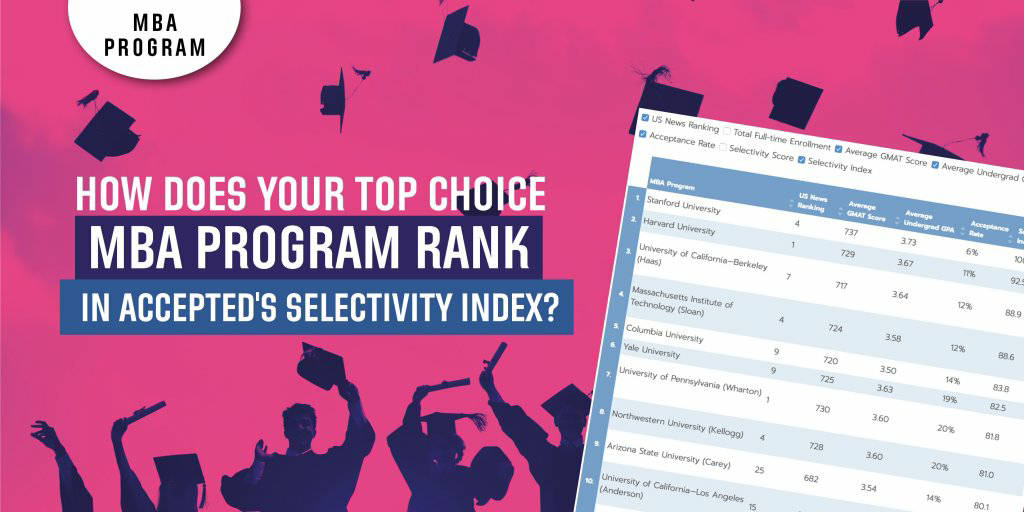
This year’s Selectivity Index™ is here!
Two years ago, Accepted developed the MBA Selectivity Index to help you apply realistically and effectively to business school. The index takes the most recent U.S. News rankings data and reflects the schools’ average GPA, test scores, and acceptance rates so that you can assess the relative difficulty of acceptance. You can also order the schools by average test score, GPA, or acceptance rate.
We chose to focus on these key metrics not because they are solely determinative (because they are not), but because they do illustrate how difficult it is to gain acceptance to a school. These particular metrics also suggest which schools may be focusing on a certain aspect of an applicant’s profile and which may not.
Average GMAT and GPA for Top MBA Programs
Here are some stats we found when analyzing the U.S. News data this year:
• Stanford GSB is #1 on the Selectivity Index again (and also 4th again on the U.S. News rankings), with the highest average GMAT score (737), highest average GPA (3.74), and lowest acceptance rate (5.7%) of all schools on the list.
• Harvard is #2 on the Index (ranked #1 in the U.S. News rankings), with negligibly lower GMAT scores and GPA, but with a significantly higher acceptance rate at 9.9%.
• Across the top 10 schools in the Index, the average GMAT score is 721, GPA is 3.60, and acceptance rate is 14.8%.
• Exactly 20 schools had average GMAT scores 700 or above, compared to 16 schools last year.
• 23 schools had average GPAs of 3.5 or higher this year, compared to 28 last year.
Why did we develop the Selectivity Index? Because we noticed that our clients tended to:
• Apply exclusively to schools where they were not competitive.
They were basing this decision on the stats and available information (which was inadequate – the Selectivity Index just wasn’t there yet).
• Focus on the one metric where they were either very strong or very weak.
Focusing on the one number that either makes you feel great or makes you feel terrible means that you fail to choose schools realistically, and consequently “invest” poorly in your overall application effort.
• Ignore weaknesses.
This generally results in a failure to address or mitigate the weaknesses. If you’re going to ignore them, you’re not going to fix them!
At Accepted, we don’t routinely discourage our clients from pursuing their dream schools – all you have to lose is the time spent putting together the application and the fee to submit, and at the end of the day you never know what might capture the attention of an admissions committee. That said, it makes sense for you to realistically assess your competitiveness at your target schools by comparing your test scores and grades as well as the non-quantitative factors in your profile to the known stats and stated criteria of the schools you want to attend.
How to Use the Information in the Selectivity Index
You can’t apply to b-school in a bubble. You must evaluate your qualifications in parallel to the average stats for your target schools. Here’s what we recommend you do:
• Apply to a few dream schools, but mostly to programs where you are competitive.
• Assess your weaknesses and strengths in the context of your overall application so that you neither obsess over a weakness nor fail to provide positive reasons for acceptance.
• Work to mitigate weaknesses before and during the actual application process while highlighting strengths and creating a strong case for acceptance beyond the stats in your application.
A few of you may be thinking:
“I know my chances aren’t great at my target schools. But I’m working and making good money. It doesn’t pay for me to apply to any but the most prestigious schools.”
There are some applicants in this situation, but very few. If you’re one of them, you are applying rationally. If you aren’t one of them and you could achieve your goals at programs where you are competitive, then chances are you are relying too heavily on reputation over fit.
Weaknesses in the MBA Selectivity Index
While we feel this is a useful tool for anyone considering business school when it comes to just stats, there are some things missing.
1. The Selectivity Index doesn’t reflect non-quantitative information, which does play a significant role in the holistic admissions process, and can allow those with non-quantitative strengths to get in despite lower-than-average stats.
2. It doesn’t reflect the schools’ desire for diversity in their classes and community. Depending on your demographic profile, you may have a lower or higher bar to hit to be considered competitive for admission.
3. It doesn’t reflect the importance of showing fit with an individual school’s strengths, mission, and values. It is up to you to do the appropriate research, including (if possible) visits to the school, attendance at admissions events, and/or connecting with current students or alumni. At the end of the day, the results of that research are much more important in helping you determine where to apply than stats could ever be.
4. It does not measure or reflect ROI, educational quality, or career opportunity, which are all things you should factor into your decision-making process.
Finally, while the Selectivity Index does reveal the relative level of competition at different programs, it doesn’t excuse you from making sure that the schools where you are competitive will also help you achieve your goals. It does you no good to get into a program that won’t help you go down your chosen path and realize your dreams.
Get an Admissions Consultant's Help with Your MBA Application
Looking for an additional way to improve your odds? Work with an Accepted admissions consultant to be sure that you are getting the best advice possible to position yourself well at your schools of choice. Don’t find yourself disappointed at the end of the admissions cycle – work with Accepted, sharpen your competitive edge…and get accepted!
 Jen Weld worked as an admissions consultant and Former Asst. Dir. of Admissions at Cornell’s EMBA program (4 years) prior to joining Accepted. She has an additional 10 years of experience in higher ed and corporate marketing. Want Jen to help you get Accepted? Click here to get in touch!
Jen Weld worked as an admissions consultant and Former Asst. Dir. of Admissions at Cornell’s EMBA program (4 years) prior to joining Accepted. She has an additional 10 years of experience in higher ed and corporate marketing. Want Jen to help you get Accepted? Click here to get in touch!
Related Resources:
• Best MBA Programs: A Guide to Selecting the Right One, a free guide
• Are You a Good Fit for Your Target MBA Programs?
• Are You Targeting the Right MBA Program for You?
This article originally appeared on blog.accepted.com.
Applying to a top b-school? The talented folks at Accepted have helped hundreds of applicants get accepted to their dream programs. Whether you are figuring out where to apply, writing your application essays, or prepping for your interviews, we are just a call (or click) away.
Contact us, and get matched up with the consultant who will help you get accepted!

